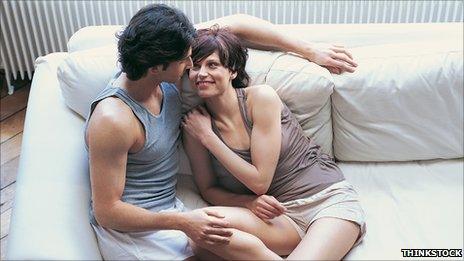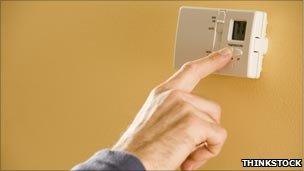How warm is your home?
- Published
- comments

Is winter really the time to expect to wear vest tops?
Our homes are getting warmer just as the powers-that-be are asking us to turn our thermostats down. How cool is too cool for a house?
Spring is in the air in the UK, but it will be weeks - if not months - before the nation's radiators switch off.
The average indoor temperatures of British houses are creeping up now central heating is the norm, and double glazing and insulation are added to older, draughtier homes.
In the Department of Energy and Climate Change's new online modelling tool My 2050, external, users can decide what they want the UK to be like in 39 years' time. The only caveat? Carbon emissions must drop 80% while keeping the lights on.
It shows that hitting this target requires more than extra wind turbines or nuclear power stations. How many cars should be electric? Should international shipping grow or shrink?
And, most immediate to personal comfort, should the average indoor temperature of British houses continue to rise, stay roughly the same at 17.5C (63.5F), or fall?
Dropping it to 16C - the lowest setting in this virtual world - only shaves 7% off carbon emissions. Even if we all get in the habit of wearing woollies inside, this will still feel chillier than usual to most people.
David MacKay, the DECC's chief scientific adviser, practises what he preaches in his once draughty semi-detached 1940s house. As well as adding double glazing and insulation, he has turned the heating right down.
"When I'm at home, my normal thermostat settings are roughly 13C, but lower when I am out, and 15C, briefly, at getting-up time in the morning. One important additional rule is that whenever I feel cold, I turn the thermostat up as high as I like. The automatic thermostat control then turns it back to the normal settings a few hours later."
He hopes that insulating more homes, smarter thermostats and "the promotion of sweater-wearing by sexy personalities" will encourage more people to follow suit.
But to many, a thermostat set in the low teens may sound unconscionably frugal - especially when the range of numbers commonly goes from 10 to 30C.
Comfort cannot be defined absolutely, but the World Health Organization's standard for warmth says 18C (64F) is suitable for healthy people who are appropriately dressed. For those with respiratory problems or allergies, they recommend a minimum of 16C (60.8C); and for the sick, disabled, very old or very young, a minimum of 20C (68F).
Our expectations of thermal comfort have been raised by central heating at home and at work, and because we are more sedentary. Those sitting still feel the cold quicker than someone moving about.

Wrap up warm to get cosy
"A human's perception of whether they feel warm depends on what they are doing, and what they've been doing for the past hour or so," says Dr MacKay in his book Sustainable Energy - Without The Hot Air.
According to one widely quoted model, initially devised in 1997 by the Building Research Establishment and used in My 2050, average indoor temperatures have risen from 12C in 1970 to about 17.5C (63.5F) today.
But, says Michelle Shipworth of the UCL Energy Institute, this model assumes we are turning our thermostats up, to explain why energy use hasn't gone down as homes have become more energy efficient.
What has happened, she says, is that we now heat more rooms, and for longer.
Forty years ago, few houses had central heating, and chilly hallways and spare rooms dragged the average temperature down. Radiators now warm rooms that previous generations wouldn't have heated - corridors, bedrooms, and bathrooms.
The last comprehensive measurement of home indoor temperatures is from 1996, when the English House Condition Survey found although living room temperatures in winter had hovered around the 19C-mark since 1986, hallways had warmed - up from 16.3C to 17.9C.
"And for bedrooms, you'll be far more comfortable while you're asleep if it is about 14 or 15C," says Shipworth.
Dr Lucy Worsley, curator of the Historic Royal Palaces, agrees. "My grandmother wouldn't sleep in a heated bedroom, and would always have a window open. You can't imagine many people today feel the same."
In our enthusiasm for cosy homes, she says many of us are like the profligate Georgians.
"A warm living room showed you were a good host and a generous person. They thought an element of wastefulness showed you had enough cash to be generous," says Worsley, presenter of BBC Four's If Walls Could Talk, a history of our homes to be broadcast in April.
"In medieval times, heating your home was akin to burning money. There was a 16th Century saying, 'the game's not worth the candle' - a task was only worth doing if it justified the expense of illumination.
"But when people began to have more spare time and spare money, considerations of waste became less important."
With energy bills soaring in recent years, and more people aware of energy consumption, she expects frugality to be thrust upon us once more.
"I do think the future will be medieval, when the big bang comes and we run out of oil. Small windows, shutters on the outside, a chimney for natural ventilation."
And expectations can be adjusted down as well as up. In Japan, there is a move away from super-cooling and over-heating office buildings. Government officials are encouraged to abandon jackets and ties in summer, and some local authorities have workers wrapped in blankets at their desks in winter.

Learning to operate a smart thermostat takes time
"In 2005, Prime Minister Koizumi decreed that no government building should be heated above 20C or cooled below 28C," says Professor Michael Kelly of Cambridge University.
"That had quite an energy saving, but no drop-off in worker productivity. Compare that to London, where the expectation is that buildings will be within a few degrees of 22C year-round."
So will smart thermostats and radiator valves help, allowing homeowners to target heat where it's needed at different times in the day?
Experts say technology can do only half the job. A smart thermostat is only as smart as the person operating it.
- Published27 January 2011